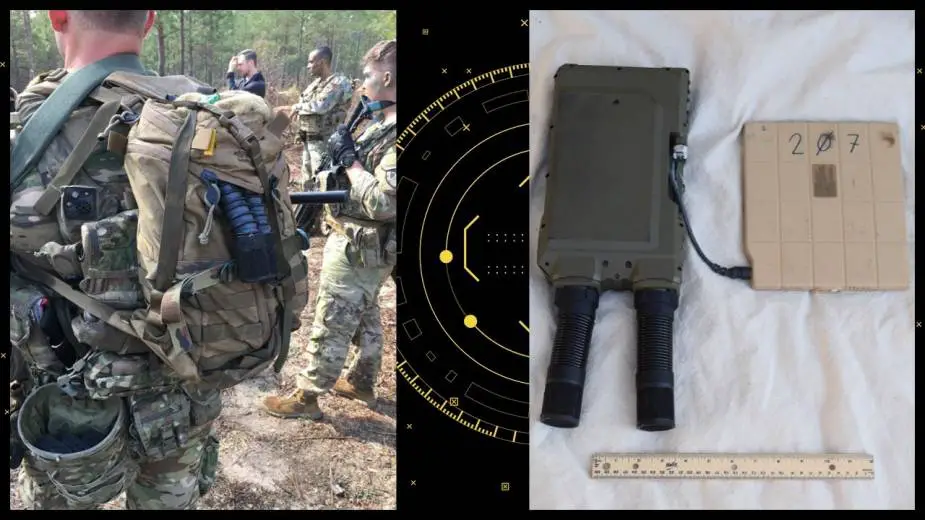US Army prototype uses windshield washer fluid to power soldier electronic devices
The U.S. Army recognizes the need to provide future soldiers with more durable and reliable energy sources and is experimenting with a variety of new and creative solutions to deliver the power required for tech-supported warfighting. Maureena Thompson, Army Futures Command, reports.
Follow Army Recognition on Google News at this link

Left: A U.S. Army soldier carries the Soldier Wearable Power Generator prototype in his backpack during a field exercise. Right: The fuel cell, pictured charging a Conformal Wearable Battery, is small enough to be easily portable but powerful enough to sustain multiple essential electronic devices used by Soldiers in the field. (Picture source: U.S. Army)
One such innovation uses commonly available, filtered windshield washer fluid — which contains the key ingredient methanol — to recharge Soldiers’ mission-critical electronic devices – such as radios and situational awareness aides – while on the go.
The tool, referred to as the Soldier Wearable Power Generator (SWPG), is a small and mobile fuel cell capable of rendering power through innovative thermal energy technology. Developed in partnership with UltraCell, the SWPG weighs 5 pounds, is designed to be soldier-worn on a backplate or carried in a backpack, and can run off either filtered windshield washer fluid or a commercial methanol/water mix.
When filtered properly, 1 pound of windshield washer fluid can provide enough energy to charge the equivalent of three Conformable Wearable Batteries that weigh 7.8 pounds; the SWPG’s refillable cartridges can be as small as 1 pound or as large as 24 pounds, depending on charging needs.
Beyond charging individual batteries, the SWPG is equipped to directly support tactical, software-based systems such as Nett Warrior. It can also feed battery-charging power scavengers, such as the Universal Battery Charger-Lite and hubs like the Integrated Soldier Power and Data System-Core. While the SWPG provides a 50-watt base load on its own, it can be paired with rechargeable lithium-ion batteries to help fuel hybrid charging systems that offer increased power surges.
The apparatus, which does not get excessively hot or cause ventilation issues for the Soldiers wearing it, seeks to address the Army’s small unit power requirement of providing on-the-move recharging capabilities that extend battery life and minimize the need for frequent battery exchange or reliance on heavy generators.
The Army’s Command, Control, Communications, Computers, Cyber, Intelligence, Surveillance and Reconnaissance (C5ISR) Center leads the service’s applied research and development in energy storage and power generation component technologies. “Army researchers are continually working on solutions to meet Soldiers' anticipated needs during this time of rapid modernization,” said Marnie Bailey, C5ISR Center’s Power Division Chief. “The SWPG is the latest example of using our in-house expertise to enable greater Soldier lethality.”
In addition to being compact, lightweight and more efficient than traditional recharging methods, the SWPG is also significantly quieter than conventional gasoline or diesel-powered generators — an important consideration in combat settings. The reception to the device has been positive, with Soldiers saying that the system does not interfere with their ability to conduct their operations.
The SWPG is just one of the unique technologies undergoing field assessment during this month’s Army Expeditionary Warrior Experiment (AEWE) at Fort Benning, Georgia. The experiment, which is hosted annually by the U.S. Army Maneuver Center of Excellence, takes a closer look at how small unit innovations — those geared toward advancing capabilities at the Soldier and squad levels — can have powerful impacts on Soldier maneuver, lethality and survivability.
Insights gathered during AEWE inform the development of priority warfighting capabilities and support the ongoing modernization work of Army Futures Command Cross-Functional Teams. For example, previous AEWE events helped to shape iterative SWPG prototypes by incorporating valuable Soldier feedback, which was then used to tailor and improve the new device.
“AEWE serves as an innovation engine, providing collaboration opportunities and Soldier touchpoints that enable capability developers to rapidly iterate tactical solutions,” said Col. Christopher Budihas, Director of the Army’s Maneuver Battle Lab, adding that “the SWPG is a great example of what this innovation engine can produce.”


























